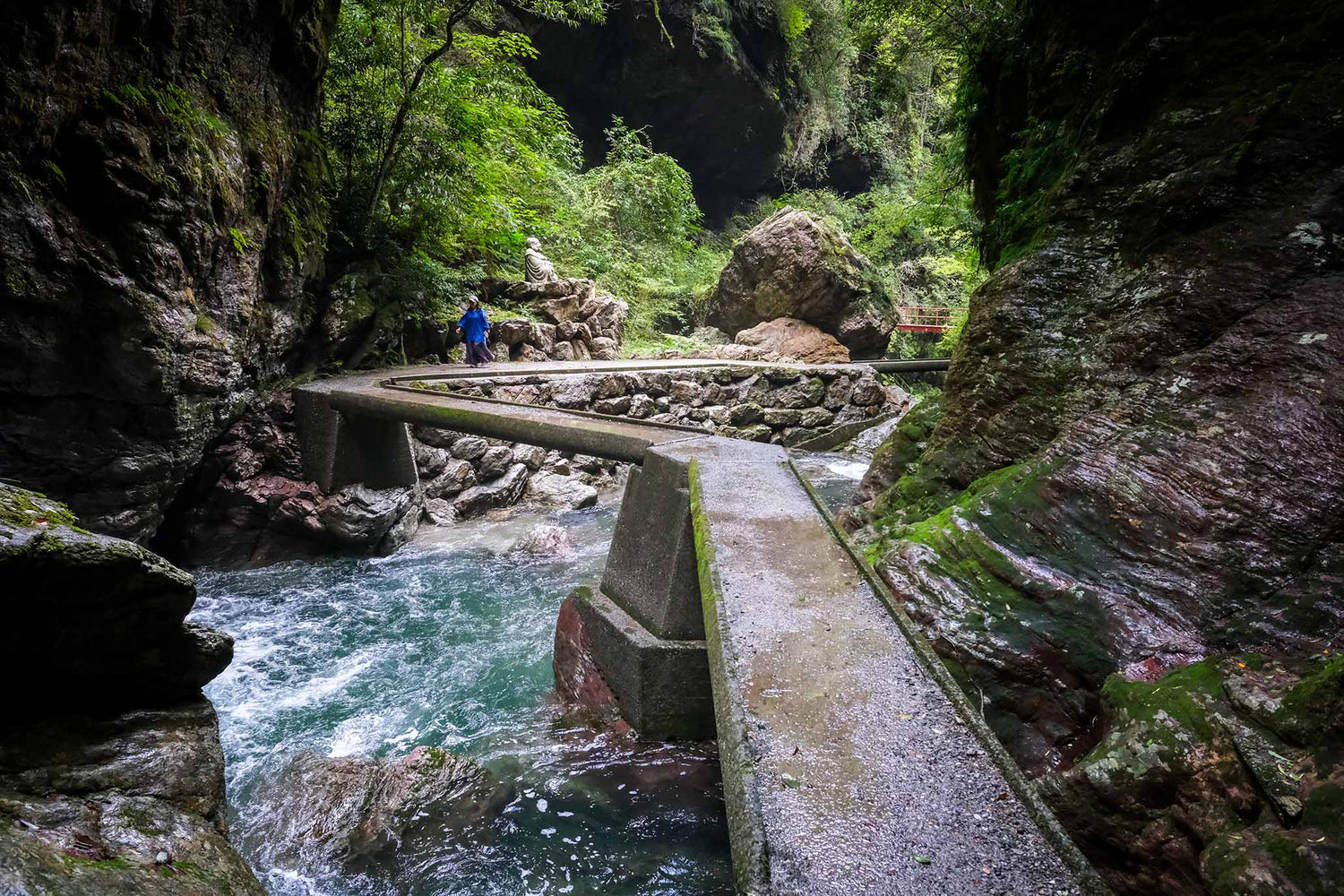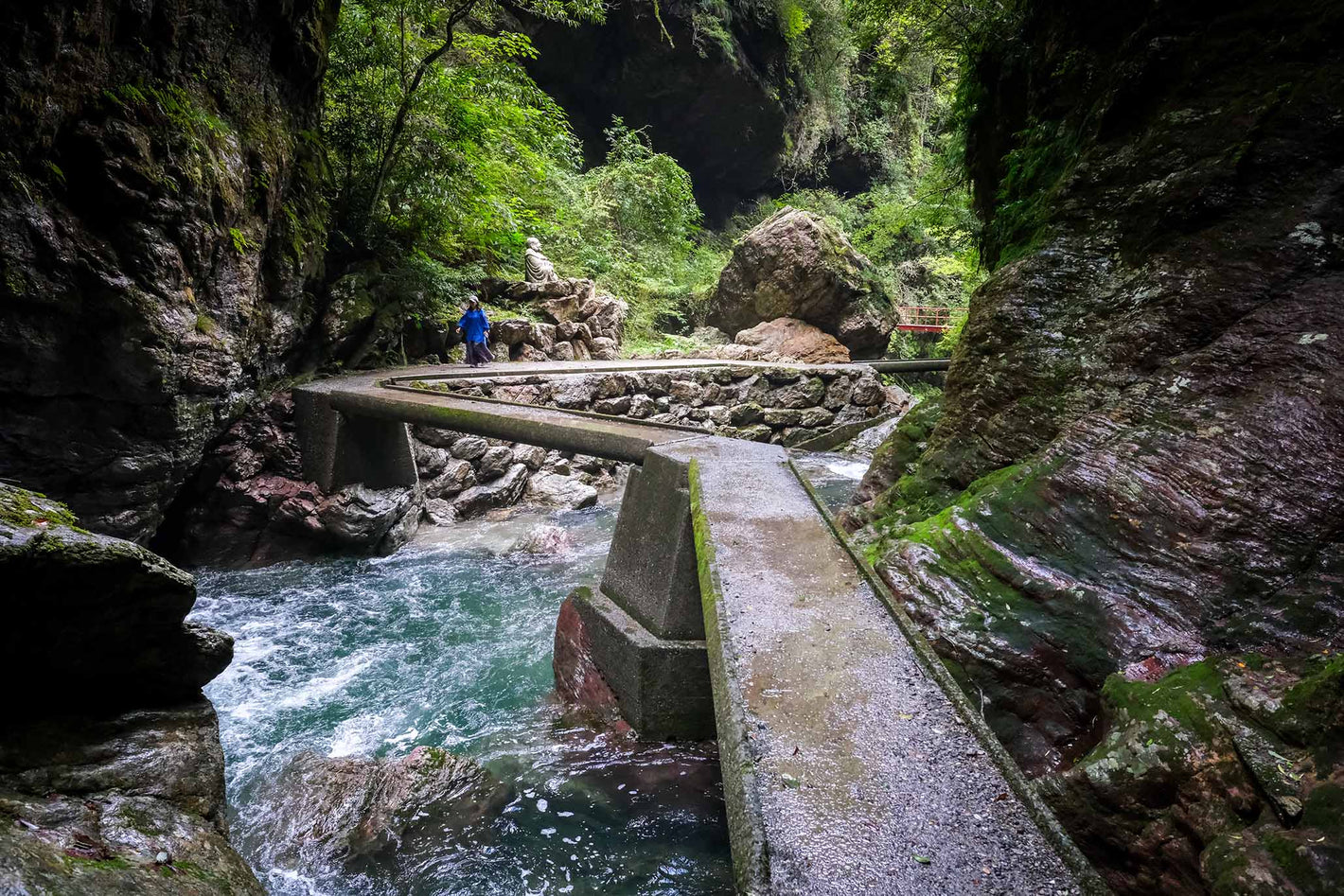Ringed by the calm waters of the Seto Inland Sea to the north and swept by the vast expanses of the Pacific Ocean to the south, Shikoku is truly a study in contrasts and if any one of the four prefectures of the island exhibit the full extent of this it is surely Kōchi, the sprawling southern prefecture of Shikoku.
From the dramatic and ever-unfolding meeting between crashing Pacific waves and stoic, rocky shoreline to the central swaths of rich farmland swaying in the Pacific breeze before gradually disappearing amid lofty stretches of forested mountainside, there is a wealth of natural beauty to uncover.
In particular, amid these mountainous stretches are scattered hidden caves, gorges, and flowing creeks, streams, and rivers that seem to negotiate any disparity between mountain and sea. One such of these bridges between the two realms is the Nakatsu Gorge, hidden away high in the mountains west of Kōchi City.
A Kōchi Kind of Blue
As one steps into the gorge, the cooling mountain air seems to blow away any lingering commotion from the outside world. In its stead are the gentle sounds of mountain forest and flowing water swirling around large, partially submerged boulders which form small, momentary eddies churning with crystalline-white foam before disappearing downstream to form the Nakatsugawa River.
The Nakatsugawa is one of the tributaries of the Niyodogawa River which is considered to be Japan’s cleanest, free-flowing river and gently rolls through the mountain valleys of central Kōchi before finally melding into the Pacific. The crystal-like waters of the Niyodogawa have long been used as a source of water, transportation, and sustenance for the Japanese and the river is even mentioned in the Engishiki, an early 10th Century compilation of laws and customs, as the source of special “ayu” (sweetfish) which were at one time offered as tribute within the walls of the Imperial Palace in Kyōto.
The waters of the Niyodogawa River are also the origin of the term “Niyodo Blue,” a general term for the unique hue of the waters found in this region. Often seen as an almost unreal shade of clear blue on the front of any number of sightseeing pamphlets, one would be forgiven to think that they were photoshopped or otherwise altered. However, this is one of those unique cases when an advertisement delivers exactly what it promises which becomes more and more evident while exploring the Nakatsu Gorge.
While walking along the stone paths and platforms bathed in the shade of the surrounding pines the flowing water becomes a constant companion and seems to change color and hue when viewed from different positions and angles. The water itself can fluctuate from a delicate, almost unreal blue that appears as a thin sheet of flawless aquamarine to a rolling flow of brilliant emerald catching the sunlight.
The exact hue of the water at any given time is due to a general lack of impurities as well as the water’s relatively cool temperature which acts to curtail the growth of algae which can cloud the surface of water. The season, weather, and time of day also affects the exact color meaning that the water’s hue can change dramatically as the mossy verdancy of the warmer months transforms into the smoldering orange hues of fall which makes for a unique visual experience with the change of the seasons.
Water from the Dragon King
Deeper into the gorge the water continues to flow while at other times it forms still and silent pools of turquoise as the mountain slope continues to rise and cast down forest shadows. Eventually the path is overtaken by ferns and moss thriving on the misty air as the current seems to quicken as if in time with the distant sounds of a waterfall echoing against the stone.
The awaiting Uryūtaki Falls make for a dramatic scene as the diamond-white water spiders down a tower of dark, craggy rock. When flowing normally, the waters are woven into intricate and elegant everchanging webs which flow in-and-out of existence just as quickly as they form. After particularly hard rainfall, the falls roar and mist as the deluge swallowed by the mountain cascades down the dark, weather-beaten rocks in an impressive and not so subtle display of nature’s power, which is more than appropriate.
The name “Uryūtaki” literally means “Rain Dragon Falls” and makes for a fitting allusion to tales of Dragon Kings found across Japan. According to folklore and legends Dragon Kings are powerful spiritual beings that can control the weather and are often found residing in powerful rivers, the sea, or even waterfalls which makes the name feel almost more than a coincidence and certainly adds something to the atmosphere of the falls.
Further contributing to a certain sense of mystery in the air are statues of the Seven Lucky Gods arranged throughout the gorge and which are easily identified by their large, gray forms which contrast with the plant life as well as the glimmering piles of coins each one collects from passersby hoping to gain some kind of blessing.
Also joining these Lucky Gods amid the stony scenery sitting above the rushing water is Fudō Myōō, a fierce Buddhist deity wreathed in the flames of Buddhist Compassion and wielding a sword to cut through ignorance and a lasso to bind delusions and other impediments encountered along the path towards Enlightenment. The presence of these deities along with some consideration for the Japanese custom of enshrining powerful beings in powerful places definitely contributes a depth to the scenery that can almost be felt when witnessing the continual cascade and flow of gleaming water over dull stone.
However, when turning back, the roar of the Uryūtaki Falls gradually grows less and less fierce as the mist begins to fade from the air until once again replaced by the pleasant chill of the mountain breeze which seems to follow along for the duration of the walk back up-stream.
And even when leaving the gorge itself and descending back onto the winding valley roads that will eventually lead to the world outside of the mountains, the flow of the water remains a constant companion even if now part of the Niyodogawa River. Though now largely reflecting the deep green of the mountainside this nevertheless shows the constant flux of nature which always seems to flow into something bigger and bigger on this place we call Shikoku.
Written by H.Sapochak
Photos by Pierre Verney

Sanuki Temari: Threads of Elegance
The green islands rising from the richly blue expanses of the Seto Inland Sea are well-known as bastions of artistic expression across the region, and this is a reputation well-deserved. After all, it is right here where travelers are able to encounter some of the most powerfully transformative and moving examples of contemporary art in Japan and arguably in the world...
In partnership with Discover Shikoku!
-
 Disover Shikoku
Disover ShikokuWelcome to Japan's most creative and bespoke travel experience, Discover Shikoku! We are a regional destination management company covering the mystical island of Shikoku, the Seto Inland Sea, and the coastal regions which surround it. If you're in search of a one-of-a-kind handcrafted travel experience fully tailored to your expectations then welcome home... We've got just what you're looking for.















